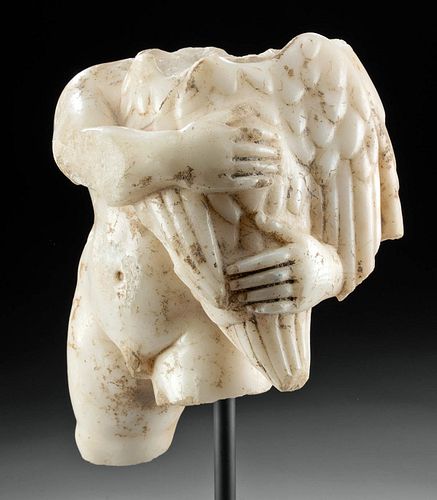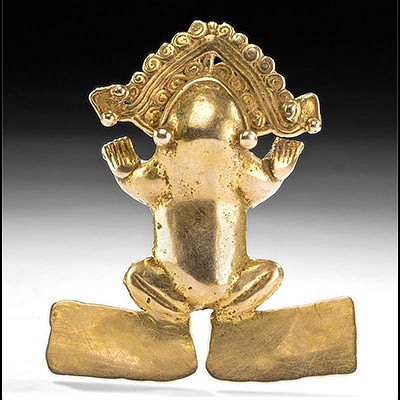Roman Marble Cupid Holding Bird, Art Loss Certificate
Lot 31
About Seller
Artemis Gallery
686 S Taylor Ave, Ste 106
Louisville, CO 80027
United States
Selling antiquities, ancient and ethnographic art online since 1993, Artemis Gallery specializes in Classical Antiquities (Egyptian, Greek, Roman, Near Eastern), Asian, Pre-Columbian, African / Tribal / Oceanographic art. Our extensive inventory includes pottery, stone, metal, wood, glass and textil...Read more
Estimate:
$30,000 - $60,000
Absentee vs Live bid
Two ways to bid:
- Leave a max absentee bid and the platform will bid on your behalf up to your maximum bid during the live auction.
- Bid live during the auction and your bids will be submitted real-time to the auctioneer.
Bid Increments
| Price | Bid Increment |
|---|---|
| $0 | $25 |
| $300 | $50 |
| $1,000 | $100 |
| $2,000 | $250 |
| $5,000 | $500 |
| $10,000 | $1,000 |
| $20,000 | $2,500 |
| $50,000 | $5,000 |
| $100,000 | $10,000 |
| $200,000 | $20,000 |
About Auction
By Artemis Gallery
Aug 13, 2020
Set Reminder
2020-08-13 10:00:00
2020-08-13 10:00:00
America/New_York
Bidsquare
Bidsquare : Fine Antiquities, Ethnographic & Fine Art
https://www.bidsquare.com/auctions/artemis-gallery/fine-antiquities-ethnographic-fine-art-5415
Features classical antiquities, ancient and ethnographic art from cultures encompassing the globe. Egyptian, Greek, Roman, Etruscan, Near Eastern, Asian, Pre-Columbian, Native American, African / Tribal, Oceanic, Spanish Colonial, Russian, Fine Art, so much more! Artemis Gallery info@artemisgallery.com
Features classical antiquities, ancient and ethnographic art from cultures encompassing the globe. Egyptian, Greek, Roman, Etruscan, Near Eastern, Asian, Pre-Columbian, Native American, African / Tribal, Oceanic, Spanish Colonial, Russian, Fine Art, so much more! Artemis Gallery info@artemisgallery.com
- Lot Description
Roman, Imperial Period, ca. 1st to 2nd century CE. Finely carved from white marble, a wonderful sculpture of Cupid (Greek Eros) holding a large bird against his chest. This iconography emerged during the Hellenistic period when sculptors introduced several charming representations of children or Erotes with their pet dogs or birds. This piece is remarkable for the sculptor's ability to turn marble to both flesh and feathers as well as to convey the dynamic motion of Cupid, his cherubic body energetically twisting as he grasps the bird. Size: 11" H (27.9 cm)
Sometimes the ancient artists captured a playful moment with the child embracing the pet with such a high degree of enthusiasm that he appears to almost suffocate the animal. Sometimes the pet’s resistance manifested in a struggle. For example, Pliny the Elder mentioned a sculpture of a child struggling a goose, the original by Boethos of Chalcedon, a Greek sculptor of the 2nd century BCE, in his Natural History (XXXIV, 84). The Boethos child became widely popular and was rendered several times by Roman sculptors. It also served as an inspirational source for multiple adaptations and variants of which the present piece is likely one.
The Boethos sculpture, known through the best copies displayed in the Capitoline Museum and the Munich Glyptothek, helps to reconstruct the composition of the fragmented Cupid. The child stands with his legs wide apart and the knees slightly bent; the body is thrown back and the head is turned toward the big bird trying to keep standing and away from the boy's embrace. The Cupid represents exactly the same action only the smaller bird does not stand on the ground and is instead lifted in the Cupid's arms.
The sculpture is very well modeled, the proportions and the round forms of child's body are realistically rendered, and attention was brought to every detail: the naval, the fingers inter-space was drilled, and the feathers of different size of both bird's and Cupid's own wings were engraved. The carefully polished surface shines, and the marble captures the quality of the child's healthy, glowing skin.
Such statuettes frequently populated the areas of recreation in a house or a villa; they have been found in the garden or in fountain arrangements. They also served as dedications to the gods related to the baby’s birth or health such as Aphrodite, Artemis, or Asklepios which is confirmed by the 3rd century BCE epigram of the poet Herodas (4. 30-31) who describes two women visiting the Asklepios sanctuary, watching and admiring the votive sculptures displayed in the precinct, the child with a goose among them.
Sources: BIEBER M., The Sculpture of the Hellenistic Age, New York, 1967, p. 81, fig. 285. RIDGWAY B. S., Hellenistic Sculpture I, The Styles of ca. 331-200 B. C., Madison, Wisconsin, 1990, p. 232. SMITH R. R. R., Hellenistic Sculpture, New York, 1991, p.136, fig. 170. On the representations of Eros and a bird, see: Lexicon Iconographicum Mythologiae Classicae (LIMC), vol. III, Zürich-Munchen, 1986, s.v. Eros, p. 871, nos. 205-219.
This piece is accompanied by Art Loss Register document - MA.FRA.016 - dated 11 August 2004 - signed by William Webber.
Provenance: ex private German collection, collected ca. 1980; Accompanied by Art Loss Register document - MA.FRA.016 - dated 11 August 2004 - signed by William Webber.
All items legal to buy/sell under U.S. Statute covering cultural patrimony Code 2600, CHAPTER 14, and are guaranteed to be as described or your money back.
A Certificate of Authenticity will accompany all winning bids.
We ship worldwide and handle all shipping in-house for your convenience.
#153131A large fragment with losses to Cupid's wings, head, legs, right elbow, losses to bird's wing tips and head. Surface wear commensurate with age showing abraded areas and nicks. Nice deposits grace the surface as well.Condition
- Shipping Info
-
All shipping is handled in-house for your convenience. Your invoice from Artemis Gallery will include shipping calculation instructions. If in doubt, please inquire BEFORE bidding for estimated shipping costs for individual items.
-
- Buyer's Premium



 EUR
EUR CAD
CAD AUD
AUD GBP
GBP MXN
MXN HKD
HKD CNY
CNY MYR
MYR SEK
SEK SGD
SGD CHF
CHF THB
THB














